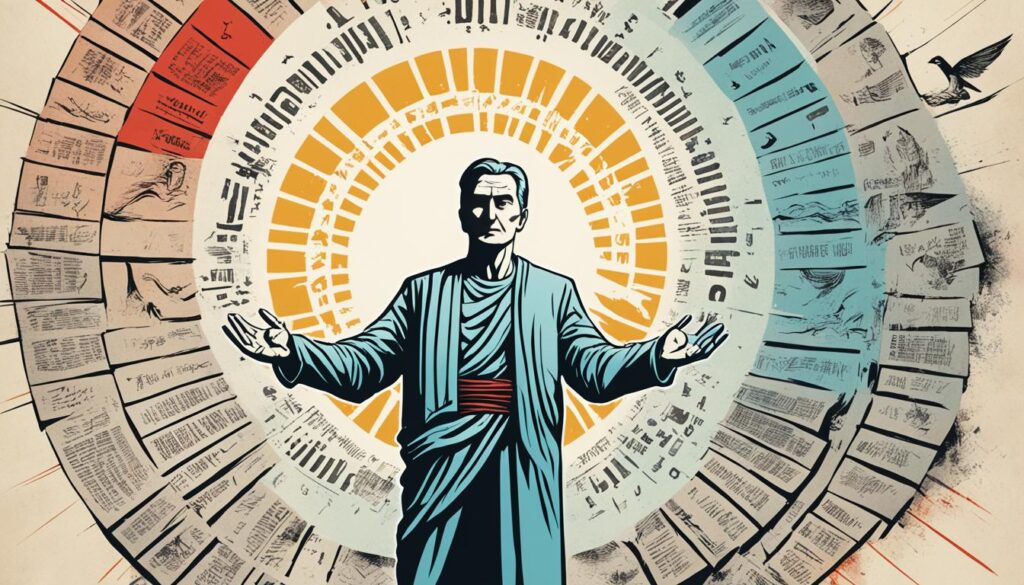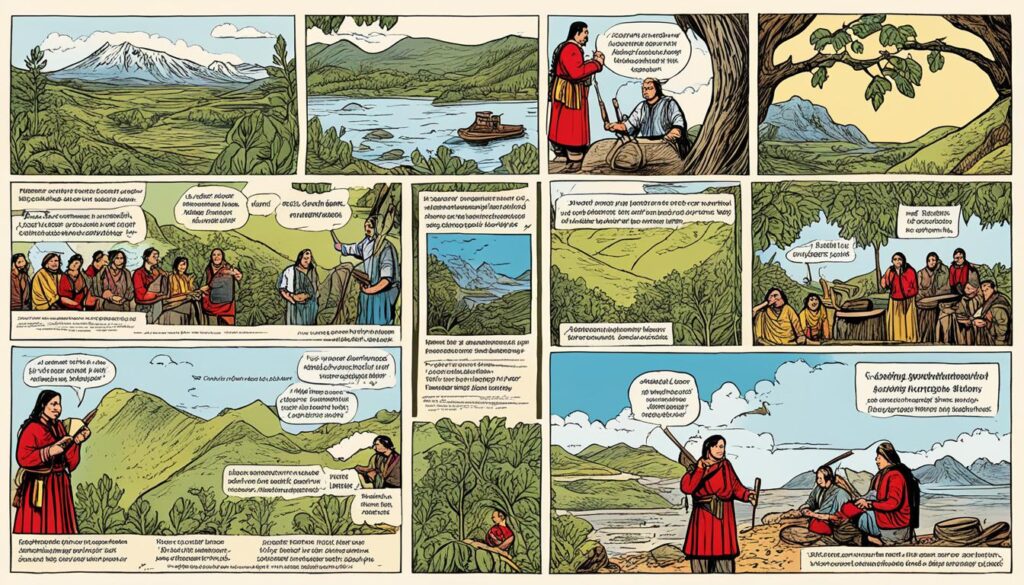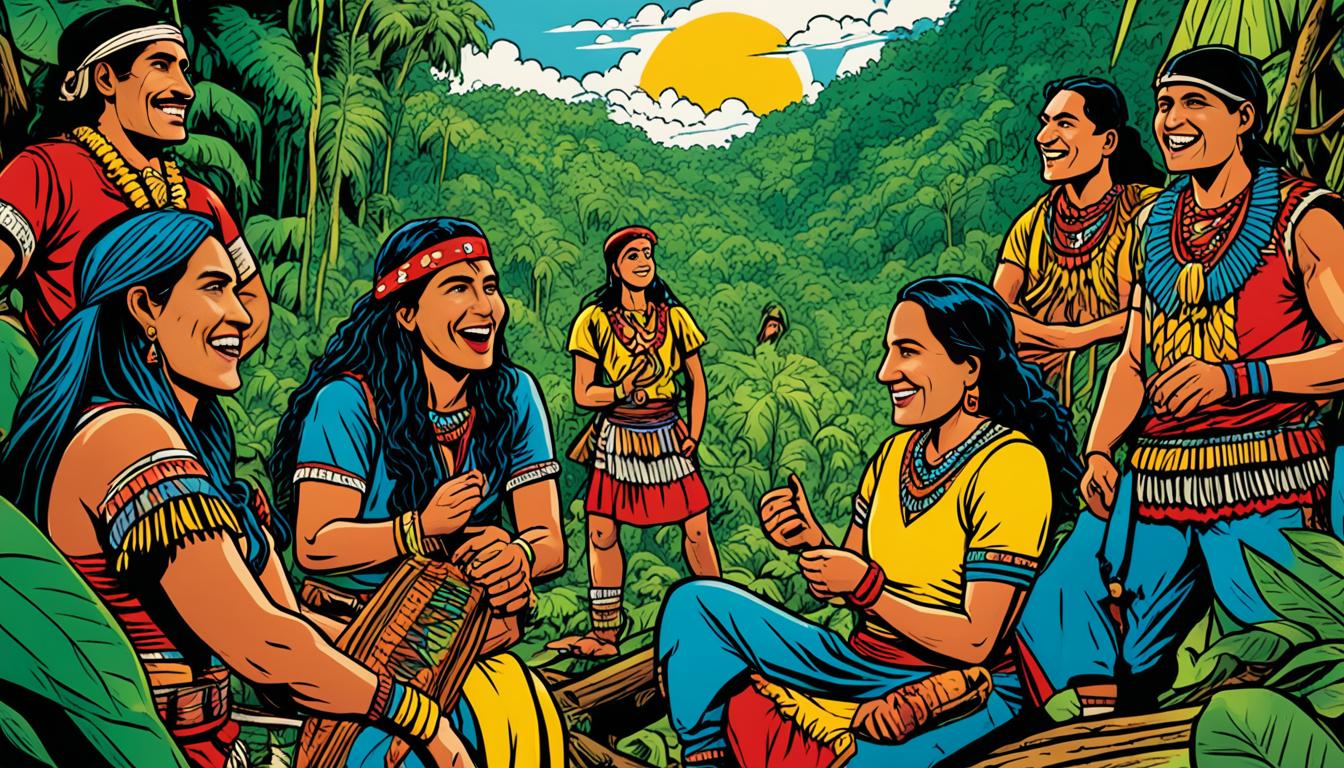Did you know that the Palikúr Language, spoken by the indigenous Palikúr people in Brazil and French Guiana, is classified as an endangered language? With only approximately 1,500 native speakers remaining, this linguistic treasure is at risk of disappearing, taking with it a rich cultural and linguistic heritage.
Language revival and preservation efforts are now underway to safeguard the Palikúr Language and ensure its survival for future generations. Join us as we explore the importance of linguistic diversity, the cultural significance of the Palikúr people, and the crucial role that language documentation and revitalization play in preserving this endangered language. Discover how the efforts of dedicated linguists, community members, and government agencies are breathing new life into the Palikúr Language and securing its rightful place in Brazil’s linguistic landscape.
The Rich Heritage of the Palikúr People
The Palikúr people possess a vibrant cultural heritage that spans their language, traditional practices, and knowledge systems. They are renowned for their exquisite artwork, intricate handicrafts, and captivating traditional dances. At the heart of their cultural identity lies the Palikúr Language, which serves as a vital tool for preserving and passing down their heritage from one generation to the next.
The Palikúr people, residing in Brazil and French Guiana, have a profound appreciation for their indigenous culture. Their language, which is deeply embedded in their everyday lives, allows for the transmission of ancestral wisdom and the maintenance of their distinctive way of life. Through the Palikúr Language, the Palikúr people convey their traditions, stories, and values, securing their cultural legacy for future generations.
The Palikúr Language serves as a bridge that connects the Palikúr people to their roots, enabling them to maintain a sense of belonging and preserve their cultural identity within an ever-changing world.
“Our language is the essence of our identity. It holds the key to who we are as Palikúr people. Without it, we risk losing a vital part of our heritage and disconnecting from our ancestors.” – Palikúr Elder
In addition to their linguistic heritage, the Palikúr people cherish their traditional practices, such as crafting intricate pottery, weaving intricate textiles, and creating unique jewelry. These artisanal skills are passed down through generations, serving as a testament to the cultural resilience and ingenuity of the Palikúr people.
Preserving the Palikúr Heritage
Efforts are underway to safeguard the Palikúr heritage and ensure the continued vitality of the Palikúr Language. Community-led initiatives, in collaboration with linguistic experts, aim to revitalize and promote the use of the Palikúr Language among younger generations. Language immersion programs, cultural festivals, and educational materials contribute to the preservation and revitalization of the Palikúr language and culture.
| Traditional Practices | Artwork | Dances |
|---|---|---|
| Handicrafts | Pottery | Traditional |
| Weaving | Textiles | Ceremonial |
| Jewelry Making | Sculptures | Storytelling |
The concerted efforts to preserve the Palikúr heritage also extend to raising awareness of the importance of linguistic diversity and indigenous cultural preservation. By acknowledging and celebrating the cultural contributions of the Palikúr people and their language, we can inspire a greater appreciation for linguistic diversity and foster a world that embraces and values the richness of indigenous cultures.
The Endangered Status of the Palikúr Language
The Palikúr language, spoken by the Palikúr people in Brazil and French Guiana, faces an endangered status. In French Guiana, the language is considered endangered, while in Brazil, it is vulnerable. The number of native speakers has been steadily declining, posing a threat to the survival of this unique linguistic heritage.
One of the primary reasons for the decline in Palikúr speakers is the younger generation’s shifting preference towards dominant languages like Portuguese and French. Without immediate action, the Palikúr language risks fading away, along with its rich cultural significance.
The consequences of losing the Palikúr language would be severe. Alongside the loss of linguistic diversity, a valuable part of Brazil’s cultural heritage would vanish. The knowledge embedded within the Palikúr language, including traditional practices, stories, and customs, would be irretrievably lost.
However, there is hope for the preservation of the Palikúr language. Language revitalization efforts and a focus on community-based preservation initiatives are vital to its survival. By documenting and documenting the language, linguists and researchers can create valuable resources for future revitalization projects.
“Preserving endangered languages is crucial for maintaining our linguistic and cultural diversity. The Palikúr language deserves attention and support from all stakeholders to ensure its continued existence.”
To combat the endangerment of the Palikúr language, language revitalization programs have been initiated. These programs aim to encourage the use of the language among community members, especially the younger generation, through language learning initiatives and educational materials development. By promoting intergenerational language transmission, these efforts ensure the continuity of the Palikúr language.
Collaboration between linguists, community members, and government agencies is essential for the success of language revitalization initiatives. By working together, we can help preserve the Palikúr language and contribute to the broader efforts of linguistic preservation and cultural heritage.
Next, we will explore the importance of linguistic diversity and its relation to the preservation of Palikúr and other endangered languages.

The Importance of Linguistic Diversity
Linguistic diversity plays a crucial role in maintaining cultural diversity and preserving unique knowledge systems. It is through languages that communities express their identity, values, and traditions. The Palikúr Language, spoken by the Palikúr people in Brazil and French Guiana, is an essential component of Brazil’s linguistic landscape and contributes to the overall linguistic diversity of the country.
Preserving indigenous languages like Palikúr is not only a matter of cultural heritage but also a means to ensure the continuation of indigenous knowledge and traditions. These languages contain valuable insights about the environment, medicinal plants, traditional practices, and worldviews that have been passed down through generations. The loss of indigenous languages represents the extinction of unique perspectives on life and the natural world.
Furthermore, linguistic diversity fosters a deep sense of belonging and inclusivity within communities. When languages are preserved, individuals can communicate and connect with their roots, strengthening their cultural identity and pride. Conversely, the loss of a language can lead to a fracture in cultural continuity, impacting the overall well-being of indigenous communities.
To illustrate the importance of linguistic diversity, let’s take a look at the following table:
| Language | Number of Speakers |
|---|---|
| Portuguese | More than 210 million |
| Palikúr Language | Approximately 1,500 |
| Other Indigenous Languages in Brazil | More than 180 |
The table above highlights the contrast between the dominant language in Brazil, Portuguese, and the endangered Palikúr Language. While Portuguese boasts a large number of speakers, the Palikúr Language is at risk of being lost forever. This sobering reality emphasizes the urgent need to preserve and revitalize indigenous languages to maintain Brazil’s linguistic diversity.
Efforts to preserve linguistic diversity involve language revitalization initiatives, community-based language preservation programs, and the collaboration between linguists, community members, and government agencies. These collective endeavors aim to raise awareness, promote language learning, and provide resources for indigenous communities to pass their languages on to future generations.
“Linguistic diversity is the lifeblood of cultural heritage, facilitating intercultural understanding and fostering respect for the world’s countless ways of being human.” – United Nations Educational, Scientific and Cultural Organization (UNESCO)
Language Revival and Preservation Efforts
Language revival and preservation efforts for the Palikúr Language are being actively pursued by various organizations and communities. These initiatives play a crucial role in ensuring the survival and revitalization of this indigenous language.
“Preserving the Palikúr Language is not just about linguistics; it’s about preserving the cultural identity and heritage of the Palikúr people,” says Ana Silva, a linguist specializing in indigenous languages.
One of the key components of language revival initiatives is the establishment of language learning programs. These programs provide community members with the opportunity to learn and practice the Palikúr Language. Language classes are conducted by native speakers and linguistic experts who are knowledgeable about the language’s grammar, vocabulary, and pronunciation.
The development of educational materials is another important aspect of language preservation efforts. These materials, including textbooks, dictionaries, and online resources, serve as valuable tools for language learners and contribute to the documentation and standardization of the Palikúr Language.
Furthermore, intergenerational language transmission is actively promoted within the Palikúr community. Elders and native speakers play a vital role in teaching the language to younger generations. By fostering a sense of pride and belonging, this intergenerational language transmission ensures the continuity and vitality of the Palikúr Language.
The success of language revitalization initiatives heavily relies on collaborative efforts between linguists, community members, and government agencies. By working together, these stakeholders can create effective strategies, secure funding, and implement policies that support the revival and preservation of the Palikúr Language.
Community-Based Indigenous Language Programs
Community-based indigenous language programs are at the forefront of Palikúr language revival efforts. These programs are developed and led by community members, who actively participate in language revitalization activities and decision-making processes.
One noteworthy program is the “Palikúr Language Skills Workshop,” organized by the Palikúr Indigenous Association. The workshop offers language classes, cultural immersion activities, and interactive sessions focused on language preservation. Participants of all ages are encouraged to engage with the language through storytelling, traditional songs, and language games.
Additionally, indigenous language programs promote the integration of the Palikúr Language into formal education systems. Schools collaborate with local communities to develop curriculum materials that incorporate the Palikúr Language, allowing students to learn the language as part of their regular education.
These community-based initiatives not only contribute to language revival but also strengthen cultural identity and pride among community members. The Palikúr Language plays a fundamental role in preserving and perpetuating the unique heritage of the Palikúr people.
Language revival and preservation initiatives are crucial for the long-term survival and vitality of the Palikúr Language. By preserving this indigenous language, we preserve a rich cultural heritage and contribute to the overall linguistic diversity of Brazil.
The Role of Language Documentation in Preserving Palikúr
Language documentation plays a vital role in the preservation of endangered languages like Palikúr. Linguists and researchers work closely with native speakers to document and analyze the linguistic features, grammar, and vocabulary of the Palikúr Language. This documentation serves as a valuable resource for future language revitalization efforts and ensures the long-term preservation of the language.
Through extensive linguistic research and documentation efforts, experts capture and record the unique linguistic aspects of Palikúr, including its phonetics, grammar rules, and vocabulary. The data collected during these documentation projects helps shed light on the intricate structure and historical development of the language. This information is then meticulously analyzed to identify linguistic patterns, variations, and changes over time.
The documentation of the Palikúr Language not only serves as a record of the language but also contributes to the broader field of linguistic research. By studying and comparing Palikúr to other indigenous languages, linguists can uncover valuable insights into the diversity of human languages and the intricacies of language evolution.
“Language documentation is a crucial step in the preservation of endangered languages like Palikúr. By thoroughly documenting every aspect of the language, we can ensure its survival and provide future generations with a rich linguistic heritage to cherish and learn from.” – Dr. Maria da Silva, Linguistics Researcher
Moreover, language documentation efforts provide valuable resources for language revitalization initiatives. The recorded materials, including audio recordings, transcriptions, and translations, can be used to create language learning materials, such as textbooks, dictionaries, and language teaching guides. These resources are essential for language learners, educators, and community members striving to revive and preserve the Palikúr Language.
The significance of language documentation goes beyond linguistic research and revitalization efforts. It is a powerful tool for indigenous language preservation and ensuring the cultural continuity of the Palikúr people. The documentation of the Palikúr Language serves as a means of safeguarding cultural practices, intangible heritage, and traditional knowledge encoded within the language itself.
| Benefits of Language Documentation |
|---|
| Preservation of linguistic diversity |
| Contributions to linguistic research and comparative studies |
| Creation of language learning materials |
| Enhancing cultural preservation efforts |
In conclusion, language documentation plays a crucial role in the preservation and revitalization of endangered languages such as Palikúr. Through collaboration between linguists, researchers, and native speakers, the documentation of the Palikúr Language ensures its long-term survival, contributes to linguistic research, and supports the efforts to revitalize and preserve the cultural heritage of the Palikúr people.

Palikúr Language and Cultural Identity
The Palikúr Language is an integral part of the cultural identity of the Palikúr people. It serves as a marker of their unique heritage and plays a significant role in maintaining their cultural identity. The language embodies the essence of their traditions, customs, and values, serving as a connection to their ancestors and a bridge to future generations.
Language and identity are deeply intertwined. The Palikúr Language not only enables communication but also preserves indigenous knowledge, history, and spirituality. It carries the wisdom of generations, containing the stories, myths, and rituals that define the Palikúr people’s cultural fabric. The language serves as a living testament to their resilience, strength, and shared experiences.
By revitalizing and preserving the Palikúr Language, the Palikúr people can affirm and reclaim their cultural heritage and assert their inherent right to self-determination. Language revitalization efforts empower communities, fostering a sense of pride and belonging, while bolstering cultural diversity and fostering intercultural understanding.
“Our language is our identity. It carries the essence of who we are as Palikúr people. Preserving and revitalizing our language is not only essential for our cultural survival but also for the well-being and empowerment of our community.” – Sônia Palikúr, Community Elder
The Role of Cultural Preservation in Language Revitalization
Cultural preservation goes hand in hand with language revitalization. The revitalization of the Palikúr Language involves not only linguistic aspects but also the revival of cultural practices, traditions, and values. Language serves as a vessel for the transmission of traditional knowledge, including ecological wisdom, medicinal practices, and sustainable ways of life.
Efforts to preserve the Palikúr Language entail the recording and documentation of cultural practices, songs, dances, and oral histories. By engaging with their cultural heritage, community members not only strengthen their language skills but also deepen their understanding and appreciation of their unique identity.
The use of the Palikúr Language in various domains of community life, such as education, governance, and cultural ceremonies, is crucial for its vitality and preservation. It ensures that the language remains relevant, dynamic, and adaptable to the evolving needs and aspirations of the Palikúr people.
Conclusion
The Palikúr Language stands as a precious indigenous language that is currently undergoing revival and preservation efforts. With the collective support of linguistic experts, community members, and government agencies, there is a glimmer of hope for the revitalization and conservation of the Palikúr Language. The preservation of indigenous languages like Palikúr holds immense significance, not only for safeguarding cultural heritage but also for upholding linguistic diversity and fostering intercultural understanding.
Languages act as gateways to cultural heritage, serving as conduits for the transmission of traditional knowledge systems, stories, and customs. The Palikúr people possess a rich cultural heritage that is intricately tied to their language. By preserving and revitalizing the Palikúr Language, we ensure the continuation of their unique cultural identity and enable future generations to maintain a strong sense of self and belonging.
Language preservation efforts involve collaborative initiatives between linguists, community members, and government entities. Through language learning programs, the development of educational materials, and the promotion of intergenerational language transmission, these efforts aim to empower the Palikúr community in reclaiming and celebrating their linguistic heritage. Moreover, language documentation plays a pivotal role in the long-term preservation of the Palikúr Language, serving as a valuable resource for future revitalization endeavors.
As we work together to revive and preserve the Palikúr Language, we not only protect an invaluable cultural asset but also promote inclusivity and respect for indigenous voices and perspectives. By recognizing and valuing the linguistic diversity within our societies, we foster a world that cherishes and embraces the richness of different cultures and traditions. Let us continue to support the revitalization and preservation of indigenous languages like Palikúr, honoring their immense cultural and linguistic contributions.
FAQ
What is the Palikúr Language?
The Palikúr Language is an endangered indigenous language spoken by the Palikúr people in Brazil and French Guiana.
How many native speakers does the Palikúr Language have?
The Palikúr Language has approximately 1,500 native speakers.
What efforts are being made to revitalize and preserve the Palikúr Language?
Efforts include language revitalization programs, community-based language preservation initiatives, and collaborative efforts between linguists, community members, and government agencies.
Why is linguistic diversity important?
Linguistic diversity plays a crucial role in maintaining cultural diversity and preserving unique knowledge systems. It contributes to the overall linguistic diversity of a country and ensures the continuation of indigenous knowledge and traditions.
What are some language revival and preservation efforts for the Palikúr Language?
Some initiatives include language learning programs, the development of educational materials, and the promotion of intergenerational language transmission.
Why is language documentation important for Palikúr preservation?
Language documentation allows linguists and researchers to analyze and preserve the linguistic features, grammar, and vocabulary of the Palikúr Language. It serves as a valuable resource for future language revitalization efforts and ensures the long-term preservation of the language.
How does the Palikúr Language contribute to the cultural identity of the Palikúr people?
The Palikúr Language serves as a marker of the Palikúr people’s unique heritage and plays a significant role in maintaining their cultural identity.
What is the significance of preserving the Palikúr Language?
The preservation of the Palikúr Language is crucial for preserving the cultural integrity and self-determination of the Palikúr community, as well as maintaining linguistic diversity and promoting intercultural understanding.
